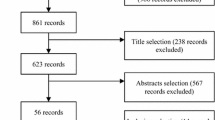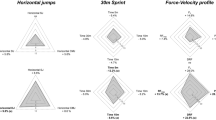Abstract
Purpose
Landing involves a tuned anticipatory control to allow for soft and safe contact with the ground. Fearful situations are known to affect postural control strategies during standing, but it is still unclear how fear interferes with the control of a voluntary dynamic task requiring coordination between posture and movement.
Methods
Ground reaction forces, limb movements, physiological arousal, and perceived levels of confidence and fear of falling were recorded when hopping off a box to a platform situated 0.8 m above ground and 3.2 m above ground.
Results
Height induced a perceived threat as arousal was augmented by the elevated surface for all subjects. Threat induced by height modifies the way participants land, leading to a stiffer landing, as evidenced by an increased loading rate at touchdown during high threat conditions. Greater psychological and physiological changes are associated with greater changes in the control of landing: individuals that are less confident/more fearful appear to compensate for this stiffer landing, by slowing down their landing.
Conclusion
Threatening conditions induces a harder contact to the ground, but the strategy is dependent of the level of confidence/fear. Less confident/more fearful participants are more focused on coping strategy and adopt a more cautious behaviour.



Similar content being viewed by others
Abbreviations
- APSI:
-
Antero-Posterior Stability Index
- A V :
-
Vertical component of the acceleration of the center of mass of the body
- BW:
-
Body weight
- c2:
-
Mass-specific damping coefficient of the system, calculated during the second part of landing
- CoM:
-
Center of mass of the body
- EDA:
-
Electro dermal activity
- FV :
-
Vertical component of the ground reaction force
- k1:
-
Mass-specific overall stiffness of the spring-mass system, calculated during the first part of landing
- k2:
-
Mass-specific overall stiffness of the spring-mass system, calculated during the second part of landing
- S V :
-
Vertical displacement of the centre of mass of the body
- t AER :
-
Aerial phase
- TD:
-
Touchdown
- TO:
-
Take-off
- TTS:
-
Time to stabilization
- VSI:
-
Vertical Stability Index
- V V :
-
Vertical component of the velocity of the center of mass of the body
References
Adkin AL, Carpenter MG (2018) New insights on emotional contributions to human postural control. Front Neurol 9:789. https://doi.org/10.3389/fneur.2018.00789
Adkin AL, Frank JS, Carpenter MG, Peysar GW (2002) Fear of falling modifies anticipatory postural control. Exp Brain Res 143:160–170. https://doi.org/10.1007/s00221-001-0974-8
Brown LA, Frank JS (1997) Postural compensations to the potential consequences of instability: kinematics. Gait Posture 6:89–97. https://doi.org/10.1016/S0966-6362(96)01106-X
Brown LA, Gage WH, Polych MA, Sleik RJ, Winder TR (2002) Central set influences on gait. Age-dependent effects of postural threat. Exp Brain Res 145:286–296. https://doi.org/10.1007/s00221-002-1082-0
Caetano MJ, Gobbi LT, Sánchez-Arias MR, Stella F, Gobbi S (2009) Effects of postural threat on walking features of Parkinson’s disease patients. Neurosci Lett 452:136–140. https://doi.org/10.1016/j.neulet.2009.01.053
Carpenter MG, Frank JS, Silcher CP, Peysar GW (2001) The influence of postural threat on the control of upright stance. Exp Brain Res 138:210–218. https://doi.org/10.1007/s002210100681
Christoforidou Α, Patikas D, Bassa E, Paraschos I, Lazaridis S, Christoforidis C, Kotzamanidis C (2017) Landing from different heights: biomechanical and neuromuscular strategies in trained gymnasts and untrained prepubescent girls. J Electromyogr Kinesiol 32:1–8. https://doi.org/10.1016/j.jelekin.2016.11.003
Cloe WW (1979) Occupational fatalities related to roofs, ceilings, and floors as found in reports of OSHA Fatality/Catastrophe Investigations. Occupational Health and Safety Administration, U.S., Department of Labor, Washington DC
Davis JR, Campbell AD, Adkin AL, Carpenter MG (2009) The relationship between fear of falling and human postural control. Gait Posture 29:275–279. https://doi.org/10.1016/j.gaitpost.2008.09.006
Delbaere K, Sturnieks DL, Crombez G, Lord SR (2009) Concern about falls elicits changes in gait parameters in conditions of postural threat in older people. J Gerontol A Biol Sci Med Sci 64(2):237–242. https://doi.org/10.1093/gerona/gln014
Depla MFIA, ten Have ML, van Balkom AJLM, de Graaf R (2008) Specific fears and phobias in the general population: results from the Netherlands Mental Health Survey and Incidence Study (NEMESIS). Soc Psychiatry Psychiatr Epidemiol 43:200–208. https://doi.org/10.1007/s00127-007-0291-z
Devita P, Skelly WA (1992) Effect of landing stiffness on joint kinetics and energetics in the lower extremity. Med Sci Sports Exerc 24(1):108–115
Dyhre-Poulsen P, Simonsen EB, Voigt M (1991) Dynamic control of muscle stiffness and H reflex modulation during hopping and jumping in man. J Physiol 437:287–304. https://doi.org/10.1113/jphysiol.1991.sp018596
Fransz DP, Huurnink A, de Boode VA, Kingma I, van Dieen JH (2015) Time to stabilization in single leg drop jump landings: an examination of calculation methods and assessment of differences in sample rate, filter settings and trial length on outcome values. Gait Posture 41:63–69. https://doi.org/10.1016/j.gaitpost.2014.08.018
Gambelli CN, Theisen D, Willems PA, Schepens B (2015) Motor control of landing from a jump in simulated hypergravity. PLoS ONE 10(10):e0141574. https://doi.org/10.1371/journal.pone.0141574
Gambelli CN, Theisen D, Willems PA, Schepens B (2016a) The motor control of landing from a counter-movement jump in simulated hypogravity. J Appl Physiol 120(10):1230–1240. https://doi.org/10.1152/japplphysiol.00993.2015
Gambelli CN, Theisen D, Willems PA, Schepens B (2016b) Human motor control of landing from a drop in simulated microgravity. J Appl Physiol 121(3):760–770. https://doi.org/10.1152/japplphysiol.00305.2016
Greenwood R, Hopkins A (1976) Landing from an unexpected fall and a voluntary step. Brain 99(2):375–386. https://doi.org/10.1093/brain/99.2.375
Haas J (1977) Learning real feelings: a study of high steel ironworkers' reactions to fear and danger. Sociol Work Occup 4(2):147–170. https://doi.org/10.1177/073088847700400202
Hauck LJ, Carpenter MG, Frank JS (2008) Task-specific measures of balance efficacy, anxiety, and stability and their relationship to clinical balance performance. Gait Posture 27:676–682. https://doi.org/10.1016/j.gaitpost.2007.09.002
Hogg S (1996) A review of the validity and variability of the elevated plus-maze as an animal model of anxiety. Pharmacol Biochem Behav 54(4):21–30. https://doi.org/10.1016/0091-3057(95)02126-4
Hsiao H, Simeonov P (2001) Preventing falls from roofs: a critical review. Ergonomics 44(5):537–561. https://doi.org/10.1080/00140130110034480
Hsiao H, Simeonov P, Dotson B, Ammons D, Kau T, Chiou S (2005) Human responses to augmented virtual scaffolding models. Ergonomics 48(10):1223–1242. https://doi.org/10.1080/00140130500197112
Huppert D, Grill E, Brandt T (2013) Down on heights? One in three has visual height intolerance. J Neurol 260(2):597–604. https://doi.org/10.1007/s00415-012-6685-1
Janicak CA (1998) Fall-related deaths in the construction industry. J Saf Res 29:35–42. https://doi.org/10.1016/S0022-4375(97)00027-3
Johnson KJ, Zaback M, Tokuno CD, Carpenter MG, Adkin AL (2019) Exploring the relationship between threat-related changes in anxiety, attention focus, and postural control. Psychol Res 83(3):445–458. https://doi.org/10.1007/s00426-017-0940-0
McKinley P, Pedotti A (1992) Motor strategies in landing from a jump: the role of skill in task execution. Exp Brain Res 90:427–440. https://doi.org/10.1007/BF00227257
Melvill Jones G, Watt DGD (1971a) Observations on the control of stepping and hopping movements in man. J Physiol 219(3):709–727. https://doi.org/10.1113/jphysiol.1971.sp009684
Melvill Jones G, Watt DGD (1971b) Muscle control of landing from unexpected falls in man. J Physiol 219(3):727–737. https://doi.org/10.1113/jphysiol.1971.sp009685
Min SN, Kim JY, Parnianpour M (2012) The effects of safety handrails and the heights of scaffolds on the subjective and objective evaluation of postural stability and cardiovascular stress in novice and expert construction workers. Appl Ergon 43(3):574–581. https://doi.org/10.1016/j.apergo.2011.09.002
Parsons TJ, Pizatella TJ (1985) Safety analysis of high risk activities within the roofing industry. PB-85163236. U.S. National Technical Information Service, Springfield, VA
Santello M (2005) Review of motor control mechanisms underlying impact absorption from falls. Gait Posture 21:85–94. https://doi.org/10.1016/j.gaitpost.2004.01.005
Santello M, McDonagh MJN (1998) The control of timing and amplitude of EMG activity in landing movements in humans. Exp Physiol 83(6):857–874. https://doi.org/10.1113/expphysiol.1998.sp004165
Santello M, McDonagh MJN, Challis JH (2001) Visual and non-visual control of landing movements in humans. J Physiol 537(1):313–327. https://doi.org/10.1111/j.1469-7793.2001.0313k.x
Schniepp R, Kugler G, Wuehr M, Eckl M, Huppert D, Huth S, Pradhan C, Jahn K, Brandt T (2014) Quantification of gait changes in subjects with visual height intolerance when exposed to heights. Front Hum Neurosci 8:963. https://doi.org/10.3389/fnhum.2014.00963
Simeonov P, Hsiao H, Hendricks S (2009) Effectiveness of vertical visual reference for reducing postural instability on inclined and compliant surfaces at elevation. Appl Ergon 40(3):353–361. https://doi.org/10.1016/j.apergo.2008.11.007
Suruda A, Fosbroke D, Braddee R (1995) Fatal work-related falls from roofs. J Saf Res 26:1–8. https://doi.org/10.1016/0022-4375(94)00026-3
Taube W, Leukel C, Lauber B, Gollhofer A (2012) The drop height determines neuromuscular adaptations and changes in jump performance in stretch-shortening cycle training. Scand J Med Sci Sports 22(5):671–683. https://doi.org/10.1111/j.1600-0838.2011.01293.x
Tersteeg MC, Marple-Horvat DE, Loram ID (2012) Cautious gait in relation to knowledge and vision of height: is altered visual information the dominant influence? J Neurophysiol 107(10):2686–2691. https://doi.org/10.1152/jn.00875.2011
Viitasalo JT, Salo A, Lahtinen J (1998) Neuromuscular functioning of athletes and non-athletes in the drop jump. Eur J Appl Physiol 78(5):432–440. https://doi.org/10.1007/s004210050442
Wikstrom EA, Arrigenna MA, Tillman MD, Borsa PA (2006) Dynamic postural stability in subjects with braced functionally unstable ankles. J Athl Train 41(3):245–250
Yiou E, Deroche T, Do MC, Woodman T (2011) Influence of fear of falling on anticipatory postural control of medio-lateral stability during rapid leg flexion. Eur J Appl Physiol 111(4):611–620. https://doi.org/10.1007/s00421-010-1680-7
Zaback M, Cleworth TW, Carpenter MG, Adkin AL (2015) Personality traits and individual differences predict threat-induced changes in postural control. Hum Mov Sci 40:393–409. https://doi.org/10.1016/j.humov.2015.01.015
Zaback M, Carpenter MG, Adkin AL (2016) Threat-induced changes in attention during tests of static and anticipatory postural control. Gait Posture 45:19–24. https://doi.org/10.1016/j.gaitpost.2015.12.033
Zhang SN, Bates BT, Dufek JS (2000) Contributions of lower extremity joints to energy dissipation during landings. Med Sci Sports Exerc 32(4):812–819. https://doi.org/10.1097/00005768-200004000-00014
Acknowledgements
Université catholique de Louvain (BE), Fonds National de la Recherche Scientifique of Belgium (FNRS, BE), Natural Sciences and Engineering Research Council of Canada (NSERC, CA)
Author information
Authors and Affiliations
Contributions
All authors contributed to the study conception and design. Material preparation, data collection and analysis were performed by BS and MJL. The first draft of the manuscript was written by BS and all authors commented on previous versions of the manuscript. All authors read and approved the final manuscript.
Corresponding author
Ethics declarations
Conflict of interest
None of the authors have any conflicts of interest with this study.
Additional information
Communicated by Lori Ann Vallis.
Publisher's Note
Springer Nature remains neutral with regard to jurisdictional claims in published maps and institutional affiliations.
Appendix: Attention focus questionnaire, adapted from Johnson et al. (2019)
Appendix: Attention focus questionnaire, adapted from Johnson et al. (2019)

Rights and permissions
About this article
Cite this article
Schepens, B., Luu, M.J. & Carpenter, M.G. Control of landing under conditions of height-induced threat. Eur J Appl Physiol 120, 1827–1839 (2020). https://doi.org/10.1007/s00421-020-04413-6
Received:
Accepted:
Published:
Issue Date:
DOI: https://doi.org/10.1007/s00421-020-04413-6




